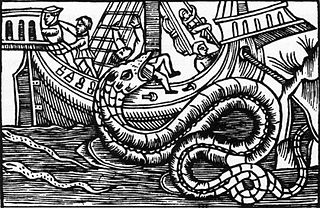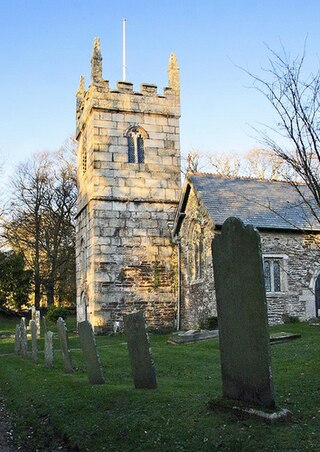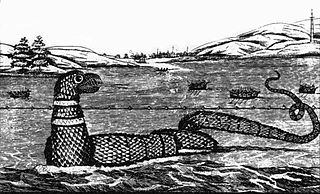In Cornish folklore, the Morgawr (meaning sea giant in Cornish) is a sea serpent that purportedly inhabits the sea near Falmouth Bay, Cornwall, England. [1]
According to legend, the creature first appeared near Pendennis Point in 1975, described as having a trunk with a very long neck and black or brown skin "like a sea lion's". Local mackerel fishermen blamed bad weather and poor fishing on supposed sightings of the monster. Some versions of the story say the monster appeared after German submarine U28 torpedoed a British merchant ship during World War I, and describe it as 60 feet long, shaped like a crocodile with four webbed feet and a powerful tail. [2] [3] [4]
Folklorists speculate that Cornish author Tony 'Doc' Shiels "invented" the creature as a hoax, having coined the name "Morgawr" after claiming to sight it in 1976. [5] According to the story, Shiels sent the Falmouth Packet newspaper photographs of the monster attributed to an anonymous individual called "Mary F". The same year in July, fishermen John Cock and George Vinnicombe claimed to have sighted the creature in the waters off Lizard Point. Also in 1976, Shiels claimed to have photographed the creature lying low in the water near Mawnan. According to some anecdotes, British writer Sheila Bird claimed to have seen the monster while walking the cliffs of Gerrans Bay in 1985. [3] [2] [4]
The legend continues to the present day with sporadic claims of Morgawr sightings on the stretch of coastline between Rosemullion Head and Toll Point popularly known as "Morgawr's Mile". [3] [2] [4]
The Falmouth-made reproduction of the Ferriby Boats was named Morgawr after the legendary beast. [9]

The Loch Ness Monster, affectionately known as Nessie, is a mythical creature in Scottish folklore that is said to inhabit Loch Ness in the Scottish Highlands. It is often described as large, long-necked, and with one or more humps protruding from the water. Popular interest and belief in the creature has varied since it was brought to worldwide attention in 1933. Evidence of its existence is anecdotal with a number of disputed photographs and sonar readings.

A sea serpent or sea dragon is a type of dragon sea monster described in various mythologies, most notably Mesopotamian (Tiamat), Judaeo-Christian (Leviathan), Greek, and Norse (Jörmungandr).

Sea monsters are beings from folklore believed to dwell in the sea and are often imagined to be of immense size. Marine monsters can take many forms, including sea dragons, sea serpents, or tentacled beasts. They can be slimy and scaly and are often pictured threatening ships or spouting jets of water. The definition of a "monster" is subjective; further, some sea monsters may have been based on scientifically accepted creatures, such as whales and types of giant and colossal squid.

In Cornish folklore, the Owlman, sometimes referred to as the Cornish Owlman, or the Owlman of Mawnan, is an owl-like humanoid creature said to have been seen in 1976 in the village of Mawnan, Cornwall, UK. Reported sightings of it flying above the church tower have led some to believe the creature may have been a barn owl, a species that commonly nests in such places.
In Canadian folklore, the Manipogo is a lake monster said to live in Lake Manitoba, Manitoba, Canada. The creature was dubbed Manipogo in 1960, the name echoing British Columbia's Ogopogo. There is also a Lake Winnipegosis monster called Winnepogo, thought possibly to be the same creature since the lakes are connected. It is the namesake of the Manipogo Provincial Park.

In American folklore, Champ or Champy is the name of a lake monster said to live in Lake Champlain, a 125-mile (201 km)-long body of fresh water shared by New York and Vermont, with a portion extending into Quebec, Canada. The legend of the monster is considered a draw for tourism in the Burlington, Vermont and Plattsburgh, New York areas.

In British folklore and urban legend, British big cats refers to the subject of reported sightings of non-native, typically large felids feral in the United Kingdom. Many of these creatures have been described as "panthers", "pumas" or "black cats".

The black dog is a supernatural, spectral, or demonic hellhound originating from English folklore that has also been seen throughout Europe and the Americas. It is usually unnaturally large with glowing red or yellow eyes, is often connected with the Devil, and is sometimes an omen of death. It is sometimes associated with electrical storms, and also with crossroads, barrows, places of execution and ancient pathways.
Bucca is a male sea-spirit in Cornish folklore, a merman, that inhabited mines and coastal communities as a hobgoblin during storms. The mythological creature is a type of water spirit likely related to the Púca from Irish, the Pwca from Welsh folklore, and the female mari-morgans, a type of mermaid from Welsh and Breton mythology. Rev W. S. Lach-Szyrma, one 19th-century writer on Cornish antiquities, suggested the Bucca had originally been an ancient pagan deity of the sea such as Irish Nechtan or British Nodens, though his claims are mainly conjecture. Folklore however records votive food offerings made on the beach similar to those made to the subterranean Knockers and may represent some form of continuity with early or pre-Christian Brittonic belief practices.

Cornish mythology is the folk tradition and mythology of the Cornish people. It consists partly of folk traditions developed in Cornwall and partly of traditions developed by Britons elsewhere before the end of the first millennium, often shared with those of the Breton and Welsh peoples. Some of this contains remnants of the mythology of pre-Christian Britain.

Lukwata is a legendary water-dwelling creature in Baganda folklore, said to be found in Lake Victoria of Uganda. It has been described as 20–30 feet long, with dark smooth skin and a rounded head, and known to attack fishermen and boats. It's stories and folklore may have also been related in some way to stories of spirits and deities surrounding canoes and fishing. Pieces of the Lukwata were thought to have magical properties and were revered as relics in eastern Africa.

A water horse is a mythical creature, such as the Ceffyl Dŵr, Capaill Uisce, the bäckahäst and kelpie.

In Canadian folklore, Cressie is the nickname given to an eel-like lake monster said to reside in Crescent Lake, Robert's Arm, Newfoundland and Labrador, Canada. The name is a portmanteau of Crescent Lake and Nessie, the nickname given to the Loch Ness Monster. The monster has been described as resembling a large dark brown eel around 15 feet in length with a long, sleek body and as "looking long and shiny, and having a fish-like head." Claims of Cressie being sighted began in the 1950s, and continue to the present day.

Anthony "Doc" Shiels is a Salford-born artist, magician and writer. After attending the Heatherley School of Fine Art in London, he moved to St Ives, Cornwall where in 1961, following the resignation of Barbara Hepworth, he was made a member of the committee of the influential Penwith Society of Arts. In St Ives he ran the progressive 'Steps Gallery', where he showed artists like Brian Wall and Bob Law. He had several solo exhibitions in London.

The stoor worm, or Mester Stoor Worm, was a gigantic evil sea serpent of Orcadian folklore, capable of contaminating plants and destroying animals and humans with its putrid breath. It is probably an Orkney variant of the Norse Jörmungandr, also known as the Midgard Serpent, or world serpent, and has been described as a sea dragon.

The Gloucester sea serpent is a legendary creature reportedly seen around and off the coast of Gloucester, Massachusetts and Cape Ann area in the United States. The heyday of sightings began in August 1817 and continued into 1818–1819. Described as a massive serpent-like creature with humps along its back, the Gloucester Sea Serpent has been the subject of numerous sightings and tales of encounters by fishermen and sailors. The earliest alleged sighting of such a creature off Cape Ann was recorded in 1638 by John Josselyn. Occasional sightings continue into the 21st century.